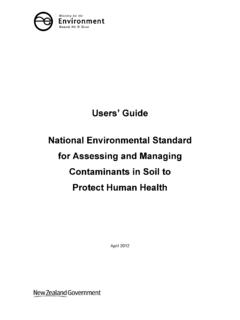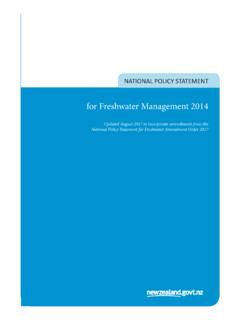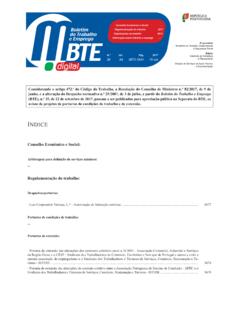Transcription of The New Zealand Emissions Trading Scheme …
1 The New Zealand Emissions Trading Scheme evaluation 2016 FEBRUARY 2016 This report may be cited as: Ministry for the Environment. 2016 . The New Zealand Emissions Trading Scheme evaluation 2016 . Wellington: Ministry for the Environment. Published in February 2016 by the Ministry for the Environment Manat M Te Taiao PO Box 10362, Wellington 6143, New Zealand ISBN: 978-0-908339-28-0 Publication number: ME 1129 Crown copyright New Zealand 2016 This document is available on the Ministry for the Environment s website: The New Zealand Emissions Trading Scheme evaluation 2016 iii Contents Executive summary 5 1 Introduction to the New Zealand Emissions Trading Scheme 7 Why does New Zealand have an Emissions Trading Scheme ?
2 7 How does the NZ ETS work? 7 International Emissions Trading 11 NZ ETS administration 12 2 The evaluation 15 Context for this evaluation 15 evaluation purpose and scope 15 Method 16 3 Long-term outcomes 21 Reduce net Emissions below business-as-usual levels 21 Meeting international climate obligations and maintaining international reputation 23 Maintaining environmental integrity, equity and economic efficiency, at the least cost, in the long run 25 4 Medium-term outcomes 26 The functioning and activity of the New Zealand carbon market 26 Low carbon investment 28 Regulatory certainty 29 Signalling future obligations 29 Maintaining business competitiveness 30 Sources of international units 30 5 Short-term outcomes 31 NZ ETS operates effectively and efficiently 31 Participants meet their obligations and have compliance information 33 Registry is secure, accurate and operates smoothly and efficiently 35 Market integrity secured through compliance oversight 35 6 Next steps 37 7 Summary of analysis 38 8 Conclusions 40 Glossary of abbreviations 41 References 42 iv The New Zealand Emissions Trading Scheme evaluation 2016 Tables Table 1.
3 NZ ETS emission units 8 Table 2: NZ ETS sector entry dates 9 Table 3: Summary of CCRA amendments in 2009 and 2012 9 Table 4: Exclusions from the scope of the evaluation 15 Table 6: Stakeholders interviewed 20 Table 7: NZ ETS impact on forest sector greenhouse gas Emissions 22 Table 8: New Zealand s Kyoto Protocol obligations and NZ ETS contribution 23 Table 9: Government administration opex costs (partial) for the NZ ETS, excluding New Zealand Unit (NZU) allocation 32 Table 10: Participants and compliance trends 2013 15 35 Table 11: evaluation of New Zealand Emissions Trading Scheme (NZ ETS) outcomes against evidence 38 Figures Figure 1: NZUs, CERs and ERUs in $NZ prices 2009 15 13 Figure 2: Types of units surrendered in 2014 14 Figure 3: Intervention logic map for the NZ ETS 18 Figure 4: Afforestation and deforestation 2000 14 23 Figure 5: Spot NZU price history ($NZ) 27 The New Zealand Emissions Trading Scheme evaluation 2016 5 Executive summary Context This report summarises the findings of the New Zealand Emissions Trading Scheme (NZ ETS) evaluation for 2015.
4 It is a supporting document for the 2015/16 NZ ETS review, and could be used to inform discussions about future policy and Scheme changes to improve its outcomes and operation. It also provides an interim methodological framework for ongoing NZ ETS monitoring and evaluation . A second stage of evaluation will follow in 2016 , with the development of a comprehensive ongoing plan for the monitoring and evaluation of the NZ ETS, informed by the framework and analysis in this report. Findings The evaluation found that the NZ ETS has been successful in assisting the Government to comply with international commitments and to meet national targets. The NZ ETS has resulted in an overachievement of New Zealand s first commitment period under the Kyoto Protocol (CP1).
5 Modelling, and other evidence, suggests that high carbon prices led to new forest planting in 2011 and 2012, but those decisions could also have been affected by other economic considerations. The resulting decrease in net Emissions below business as usual levels is small relative to net national Emissions . The result was also influenced by foresters bringing forward deforestation before CP1 began, which resulted in reduced net national reported CP1 Emissions than would have been the case without the NZ ETS. Participants interviewed from non-forestry sectors, and evidence from surveys, have indicated that because of the low carbon price over most of CP1, the NZ ETS has not significantly influenced domestic Emissions or business decisions. Almost all of those interviewed considered that regulatory certainty and stable long-term policy settings would increase the influence of the NZ ETS on business decisions.
6 The NZ ETS is administered effectively according to available qualitative information, with most participants interviewed finding the NZ ETS documentation, rules and platforms easy to navigate. This is also supported by customer surveys from the Environmental Protection Agency (and the Ministry for Primary Industries). The New Zealand carbon market is active, with price changes linked to international markets and domestic policy settings. For example, decisions to prevent the use of Kyoto Protocol emission units have led to price increases for New Zealand units. Constraints More work is needed on some performance metrics in order to assess how efficient the NZ ETS administration is for the government and participants. Information was also limited on impressions of regulatory certainty, changes in the number of compliance issues, and the long-term impacts of the NZ ETS on environmental integrity, equity, and economic efficiency.
7 Those matters, and responses to this report, will be important parts of the development of the full NZ ETS monitoring and evaluation framework in 2016 . 6 The New Zealand Emissions Trading Scheme evaluation 2016 Method This evaluation was guided by using the Context, Input, Process and Product evaluation framework. The resulting focus on the products element of the framework was detailed through intervention logic mapping to identify expected NZ ETS outcomes. This evaluation collected evidence from interviews with participants, existing surveys and international reports and has noted information gaps that have constrained analysis on some outcomes. The New Zealand Emissions Trading Scheme evaluation 2016 7 1 Introduction to the New Zealand Emissions Trading Scheme The New Zealand Emissions Trading Scheme (NZ ETS) is New Zealand s primary policy tool for addressing domestic greenhouse gas Emissions and removals, and international commitments on climate change.
8 Why does New Zealand have an Emissions Trading Scheme ? The NZ ETS was established through a 2008 amendment to the Climate Change Response Act 2002 (CCRA) to: provide for the implementation, operation, and administration of a greenhouse gas Emissions Trading Scheme in New Zealand that supports and encourages global efforts to reduce the emission of greenhouse gases .1 The NZ ETS objectives outlined in the CCRA are to: assist New Zealand to meet its international obligations under the United Nations Framework Convention on Climate Change (UNFCCC) and the Kyoto Protocol (the Protocol) reduce New Zealand s net Emissions of those gases to below business-as-usual In December 2006 through to March 2007 (before the NZ ETS was introduced), the Government consulted on possible directions for climate change policy.
9 This consultation led to implementation of an emission Trading Scheme rather than an Emissions tax as the price-based mechanism for reducing New Zealand s How does the NZ ETS work? Some people and organisations may have noticed a small increase in energy prices as businesses that participate directly in the NZ ETS pass on the related costs. Those businesses are required to acquire and surrender emission units to account for their direct greenhouse gas Emissions or the Emissions associated with their products. Businesses directly participate in the NZ ETS by: surrendering emission units to the Government for example, companies that mine natural gas, as this will emit greenhouse gases when it is used earning emission units from the Government such as owners of forests that absorb greenhouse gases being given emission units by the Government generally those companies that might face significant increases in energy costs and be unable to pass those costs on to customers.
10 1 Climate Change Response ( Emissions Trading ) Response Act 2008, section 5(1)(b). 2 Climate Change Response Act 2002, section 3(1)(b). 3 Ministry for the Environment, The Treasury, 2007. 8 The New Zealand Emissions Trading Scheme evaluation 2016 Various regulations and guidance materials set out the requirements on participants to monitor, record and report activities that produce or remove greenhouse gas Emissions , and the process for surrendering emission units to the Government to cover Emissions associated with their activities each year. Table 1 explains the emission units used in the NZ ETS. Table 1: NZ ETS emission units Emission unit Description Forestry NZUs (New Zealand units) Units given to foresters for removal activities or through the Forestry Allocation Plan.












